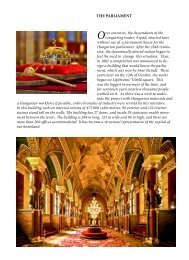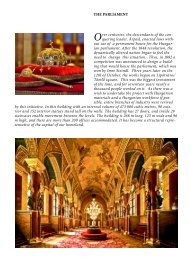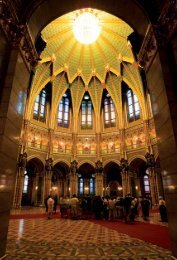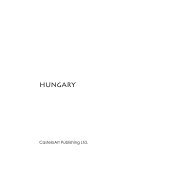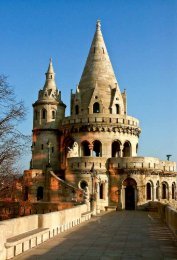BP_small_portrait
You also want an ePaper? Increase the reach of your titles
YUMPU automatically turns print PDFs into web optimized ePapers that Google loves.
w<br />
ELIZABETH BRIDGE<br />
The first steps on today’s Erzsébet híd (Elizabeth Bridge) started echoing more than a hundred years<br />
ago. At that time this crossing point above the Danube was referred to as the bridge of the Eskü tér<br />
(Promise Square) and its pavement was made of wooden cubes. Building started in 1897 when there<br />
were only two other bridges: the Lánchíd (Chain Bridge) and the Margit híd (Margaret Bridge). Although<br />
a price of two krajcár (the currency of the time, the equivalent of a penny) had to be paid in the little<br />
buildings at either end of the bridge, the citizens were glad to use the new bridge. The original bridge<br />
was bombed by the German troops in 1945. Then, only years later (November 21, 1964) was the new<br />
construction handed over.<br />
DIE ELISABETH-BRÜCKE<br />
Die ersten Schritte hallten zum ersten Mal auf dem damaligen Holzpflaster der Donaubrücke am Eskü<br />
tér – also auf der heutigen Elisabeth-Brücke – vor fast hundert Jahren. Der Brückenbau begann<br />
1897, damals existierten unter den ständigen Brücken nur die Ketten- und die Margarethenbrücke.<br />
Die für den Verkehr geöffnete Elisabeth-Brücke war eine Kettenbrücke mit der größten Öffnung der<br />
Welt. Die Bevölkerung benutzte das Bauwerk gern, obwohl man auf beiden Seiten ein Brückengeld<br />
von 2 Kreuzern zu zahlen hatte. Die ursprüngliche Brücke wurde 1945 von den Deutschen in die Luft<br />
gesprengt. Die neue Brücke wurde erst am 21. November 1964 für den Verkehr freigegeben.<br />
MOST ELŻBIETY<br />
Sul pavimento, originariamente ligneo, del Ponte Elisabetta (all’epoca dell’inaugurazione si chiamava<br />
Ponte di piazza Eskü) i passi degli ungheresi risuonano da ormai più di un secolo. L’inizio della costruzione<br />
risale al 1897 quando, dei ponti odierni, esistevano soltanto il Ponte delle Catene ed il Ponte Margherita.<br />
All’epoca era il ponte pubblico con l’arcata più grande del mondo e la gente, nonostante il pedaggio di<br />
2 crazie da pagare ai due lati del ponte, lo usò con piacere. Nel 1945 i tedeschi lo fecero saltare in aria<br />
ed il ponte ricostruito venne consegnato soltanto il 21 novembre 1964.<br />
МОСТ ЭРЖЕБЕТ<br />
Первый стук шагов на дунайской переправе, которую в былые времена упоминали как мост на<br />
площади Эшкю, прозвучал немногим более ста лет назад. Покрытие моста было сделано из<br />
деревянных плит. Сегодня это мост Эржебет. Его строительство началось в 1897 году; к этому<br />
времени из постоянных мостов существовали только Цепной мост и мост Маргит. Мост Эржебет<br />
был в те времена дорожным цепным мостом с самым большим в мире пролётом. Жители города<br />
с энтузиазмом начали пользоваться сооружением, хотя в зданиях по обе стороны моста взимали<br />
плату - 2 крайцара. Оригинальный мост в 1945 году был взорван отступающей немецкой армией;<br />
передача нового моста состоялась только 21 ноября 1964 года.<br />
24



